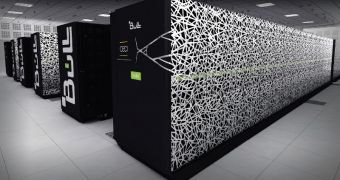A new contended seems to have joined the race for the world's fastest supercomputer, since the Bull: Tera 100 machine has officially broken the Petaflops barrier, by recording a performance of 1.05 million billion operations a second (1.05 Petaflops) in the LINPACK benchmark test, for a peak performance of 1.25 Petaflops. This performance means it ranks as the most powerful supercomputer in Europe, and it should rank one of the very best in the world as well. Tera 100 is a cluster of 4,370 bullx S series servers, equipped with 17,480 Intel Xeon 7500 processors, its central memory featuring over 140,000 memory modules, delivering a total capacity of 300 TB. Plus, the machine features some 20 petabytes (PB) of disc capacity, accessible at a world record speed of 500 GB/sec. The Bull: Tera 100 is the result of a close partnership between Bull and CEA-DAM (the Military Applications Division of the French Alternative Energies and Atomic Energy Commission) and is used to support the Simulation program at the Military Applications Division (DAM), running it for 24 hours a day. As a general-purpose production supercomputer, Tera 100 has been designed to run the widest possible range of computer simulation applications, so it is quite different from other machines dedicated to running specific applications. “This latest benchmarking of Tera 100 reaffirms Bull’s position as the European leader in computer simulation technologies,” commented Philippe Miltin, Vice President, Bull Products and Systems. “Tera 100 leverages on Bull’s expertise in the design, integration and implemention of supercomputers for production, and is based on Open Source technologies and standard Intel Xeon processors. And using these same open, high-performance and competitive technologies enables Bull to meet even the most demanding requirements of industry and research, for example in healthcare, sustainable development and homeland security,” concluded Mr. Miltin.
hot right now

 14 DAY TRIAL //
14 DAY TRIAL //